Kensington (St Mary Abbots from 1845), Middlesex, London
Up to 1834
Kensington had a parish workhouse from around 1726. In 1777, a local Act of Parliament granted the trustees of several estates charitably bequeathed to Kensington the authority to erect and furnish a new workhouse using income from the various properties. The following year, the parish erected a workhouse on the southern end of Butt's Field. A substantial H-shaped structure, it continued in use until 1849 when it was replaced by a new building on Marloes Road. The old workhouse was then demolished and the site redeveloped into the narrow square know know as Kensington Gate.
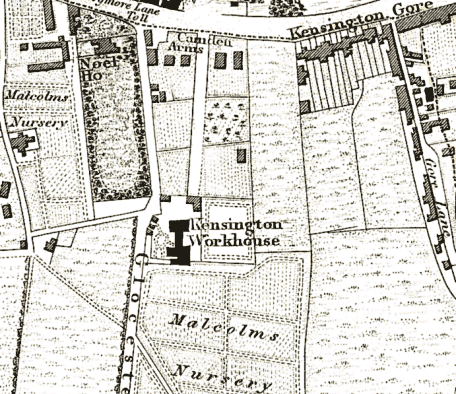
Kensington workhouse site, 1827
After 1834
Kensington Poor Law Union was formed in 1837 from the parishes of St Luke's Chelsea, Fulham, Hammersmith, Kensington and Paddington. Following this, paupers were housed in a number of former parish workhouses: males in a workhouse at Kensington, women at Chelsea, boys at Hammersmith, and girls at Fulham.
In 1845, the Kensington Union was dissolved with Fulham and Hammersmith forming a new Fulham Union. Paddington and Kensington began operating as an independent Poor Law Parishes, with Kensington adopting the name Parish of St Mary Abbots.
The Marloes Road Workhouse
In 1846, St Mary Abbots purchased a new workhouse site at the east of Wright's Lane (now Marloes Road) from Mr Gunter. In May 1847, after inspecting 35 other recently built Metropolitan workhouse, the Board of Guardians advertised for plans for a new building to cost no more than £9,000. The winning design, by Thomas Allom, was a Jacobean style red-brick construction. The architect's design is shown below.
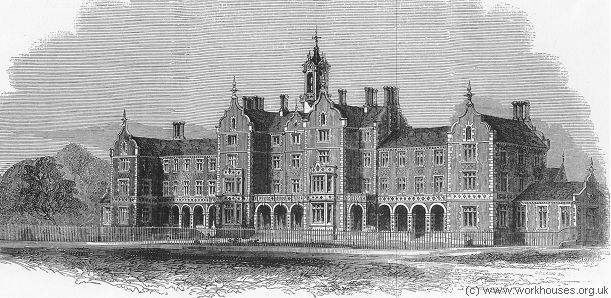
Kensington workhouse from the south-west, c.1880
The building was:
"to contain upwards of four hundred paupers, and has an infirmary with airing grounds detached from the main building. The first tender as accepted by the Board was 10,600 and some odd pounds; the second, with additions, amounted to 11,020l. The total length of frontage is 262 feet, the whole of which is given to the aged and infirm, with arcades for exercise and a garden in front. The able-bodied and younger classes are kept more immediately under the eye of the master and matron."
The workhouse layout used a double courtyard plan. Its location and layout are shown on the 1869 map below.
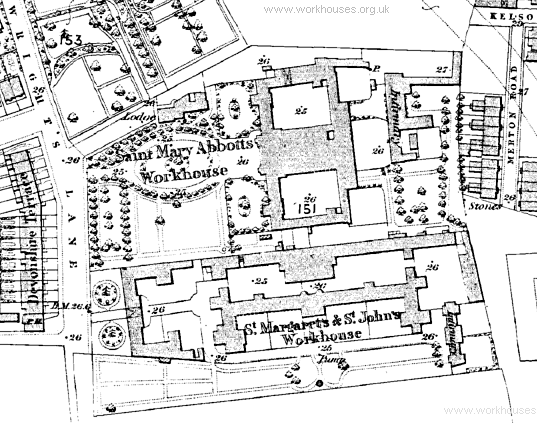
St Mary Abbots workhouse site, c.1869
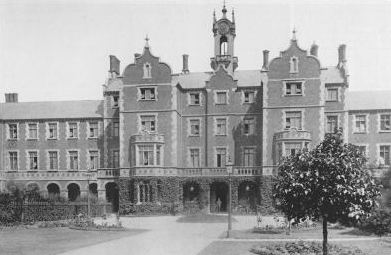
St Mary Abbots workhouse from the west, c.1880
In 1868, the recently formed Metropolitan Asylums Board set up six new Sick Asylum Districts for the purposes of providing hospital care for the poor on separate sites from workhouses. One of the new Districts, named Kensington, comprised the parishes of St Margaret and St John, Westminster, together with St Mary Abbots. However, the large new hospital required by the new scheme was felt to be too expensive and the Kensington Sick Asylum District was dissolved. Instead, St Margaret and St John joined St George, Hanover Square to form the new St George's Union. St Mary Abbots then reverted to being a Poor Law Parish.
In 1871, a large new infirmary was erected at the west of the site. It was designed by Alfred Williams of Onslow gardens. The four storey building had around 300 beds and included new laundry and dining-room facilities.
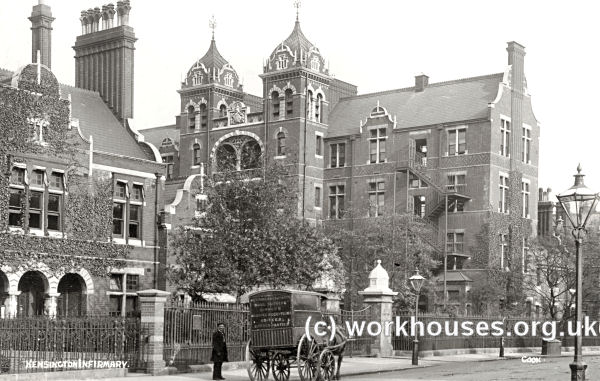
Kensington 1871 workhouse infirmary from the north-west, c.1906.
In 1875, a legacy of £2,500 was used for the erection of a chapel at the north of the new infirmary. It was designed by A.R. Blomfield in the Early English style, and was dedicated to St Elizabeth of Hungary. Also in 1875, Kensington St Mary Abbots achieved a notable first when the first ever female Guardian was elected to its board.
At the end of 1880, St Mary Abbots was able to expand its premises when it acquired the neighbouring former St Margaret and St John workhouse which had briefly been leased to the Kensington and Chelsea District School Board for accommodating pauper children. From around 1890 to 1922, the site's hospital facilities operated under the name of Kensington Infirmary.
In 1893, a new administrative block was built on Marloes Road, together with a new male infirmary to its south which comprised three linked three-storey ward pavilions. The buildings were designed by Thomas W Aldwinckle. The 1871 infirmary was then assigned as a female infirmary.
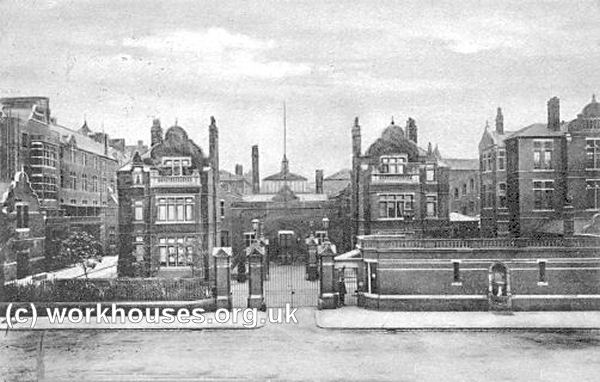
Kensington new administrative block from the west, c.1905.
The site layout in the mid-1890s is shown on the map below.
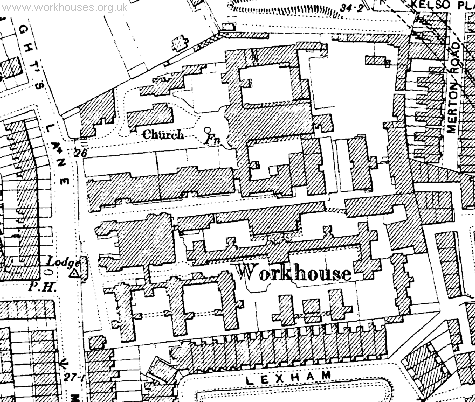
Kensington workhouse site, c.1896
After 1922, the site was known as St Mary Abbots Hospital. The building suffered substantial bomb damage during the Second World War, including the demolition of the southern end of the 1847 main block, "Stone Hall".
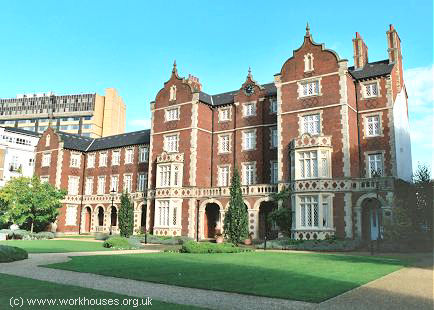
Kensington Stone Hall block, 2001.
© Peter Higginbotham.
The site has now been redeveloped for residential use although much of the original 1847 main building survives.
Mary Place Workhouse
In 1870, the parish set up a labour yard and relief office at Mary Place, Notting Hill (now Avondale Park Gardens), where able-bodied men received out-relief in return for breaking stone. A dispensary was added in 1871 and a casual ward in 1878.
In 1882, at the behest of the Local Government Board, the workhouse became an able-bodied test workhouse, accommodating able-bodied men from all London's unions. It thus followed in the footsteps of a similar establishment operated by the Poplar Union which had recently ceased in the same role. For the next twenty-two years, able-bodied men at Mary Place performed tasks such as stone-breaking, corn-grinding, and oakum picking for 55 to 60 hours a week. The only hour of leisure, from 7-8pm, was filled with "lectures" from a "Mental Instructor", at which attendance was obligatory. The diet was coarse and monotonous and smoking was forbidden. No inmate was ever allowed temporary leave to go out from the premises.
Perhaps not surprisingly, the Mary Place workhouse appears to have some success in deterring able-bodied applicants for relief. With the number of such inmates gradually declining, the workhouse gradually reverted to use as a branch workhouse for Kensington's own inmates.
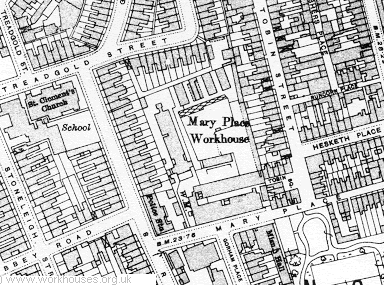
Kensington Mary Place site, 1914.
The site is now occupied by housing.
Staff
Inmates
Records
Note: many repositories impose a closure period of up to 100 years for records identifying individuals. Before travelling a long distance, always check that the records you want to consult will be available.
-
The
Ancestry UK
website has two collections of London workhouse records (both name searchable):
- Westminster workhouse records are available on FindMyPast, .
- London Metropolitan Archives, 40 Northampton Road, London EC1R OHB. Holdings for Kensington include: Guardians' minute books (1838-1930); Lists of paupers (1877-1913); etc.
Bibliography
- Higginbotham, Peter Workhouses of London and the South East (2019)
- Faulkner, T. (1820) History and Antiquities of Kensington.
- Hughes, B. (1991) From Workhouse to Hospital.
Links
- None.
Unless otherwise indicated, this page () is copyright Peter Higginbotham. Contents may not be reproduced without permission.


